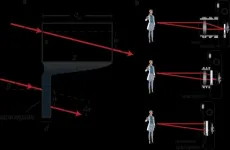(Press-News.org) Can you imagine one day using a telescope as thin as a sheet of paper, or a much smaller and lighter high-performance camera? Or no longer having that camera bump behind your smartphone?
In a paper published in Nature Communications, researchers from the University of Ottawa have proposed a new optical element that could turn these ideas into reality by dramatically miniaturizing optical devices, potentially impacting many of the applications in our lives.
To learn more about this project, we talked to lead author Dr. Orad Reshef, a senior postdoctoral fellow in the Robert Boyd Group, and research lead Dr. Jeff Lundeen, who is the Canada Research Chair in Quantum Photonics, Associate Professor in the Department of Physics at the University of Ottawa, and head of the Lundeen Lab.
Can you describe the new optical element your team developed, the spaceplate?
Orad Reshef: "Light naturally "spreads out" when it is travelling and every optical device we know of relies on this spread; we wouldn't know how to design cameras without it. For example, in every telescope there is a large gap between the eyepiece and the objective lens to give light room to spread.
"A spaceplate simulates the same spreading that light would experience travelling a large distance in a small device. To light, a spaceplate looks like "more space" than it occupies. In a way, the spaceplate is a counterpart to the lens, doing things the lens can't do to shrink down entire imaging systems.
"We introduced the idea of a spaceplate in our paper, experimentally demonstrating it and showing it is compatible with broadband light in the visible spectrum that we use to see."
Jeff Lundeen: "We considered what would happen if you manipulated light based on the angle rather than the position of a light ray. Lenses act via the position of the ray. Angle is a completely novel domain, and no one had shown that it could be used to make something particularly useful. We identified a useful application, compressing space. And then we showed that we could actually design and experimentally demonstrate plates that do exactly that."
Orad Reshef: "This is exciting because this device will let us shrink down all sorts of very large devices that we thought were impossible to miniaturize in optics. In order to design it, we need to come up with a new set of rules that is incompatible with that used in lens design. Nobody knows what they are, it's like the wild west."
How did you come up with this idea?
Jeff Lundeen: "Orad Reshef is an expert in using nanotechnology for manipulating a ray based on its position (e.g. meta-lenses or, more generally, meta-surfaces). We were casually discussing the limitations of manipulating light with these meta-surfaces and I said it would be cool to instead manipulate light based on its angle."
"Dr. Reshef was immediately confident that he could design and fabricate something that could do that and I subsequently concluded the easiest goal would be to replace the space needed for spread (i.e. propagation)."
"Over the course of the next few months, in discussions with Dr. Boyd and Dr. Reshef, we slowly realized how amazing and useful such a device would be. Both Dr. Reshef and I came up with viable and completely different designs, which showed there were many ways to create such a device. We studied three in our paper but there are more coming."
How could this technology be used? What are the applications of the spaceplate in our daily lives?
Orad Reshef: "A spaceplate can be used to miniaturize many optical systems, be it a display or a sensor. For example, an advanced spaceplate can enable paper-thin telescopes or cameras; it could be used to remove the "camera bump" on the back of your smartphone."
Jeff Lundeen: "People lug around large cameras with huge telephoto lenses. If we can sufficiently improve the spaceplate's performance, I envision the possibility of building smaller, lighter cameras with much better performance. In particular, the spaceplate combined with metalenses would allow us to make the entire back surface of, say, an iPhone Max, into a flat and thin camera. It would have as much as 14 times better resolution and low-light performance than those large and heavy cameras.
"Thin and small cameras would be useful in a wide variety of applications, including in health care where camera pills or endoscopes could look inside arteries or the digestive system."
What are the next steps?
Orad Reshef: "We are hard at work developing the next generation of this technology. We want to try and increase the compression factor and to improve the overall performance. We already have some designs to increase the compression factor from 5 to over 100 times, and to increase the total transmission. To continue doing this, we need to come up with a completely new design paradigm."
Any final thoughts?
Orad Reshef: "It's surprising that optical elements like lenses have been around for a millennium and their design rules have been well understood for over 400 years, and yet we're still discovering such fundamental new optical elements for imaging."
INFORMATION:
This research is a collaboration between two research groups of two physics professors at uOttawa, Robert Boyd, Canada Research Chair in Quantum Nonlinear Optics, and Jeff Lundeen, Canada Research Chair in Quantum Photonics. Both groups work closely together as part of the Canada Excellence Research Chair Group in Quantum Photonics (CERC) assembled by Robert Boyd (coauthor), CERC Laureate in Quantum Nonlinear Optics.
The article "An optic to replace space and its application towards ultra-thin imaging systems" is published in Nature Communications.
A class of drug called monoamine oxidase inhibitors is commonly prescribed to treat depression; the medications work by boosting levels of serotonin, the brain's "happiness hormone."
A new study by UCLA researchers suggests that those drugs, commonly known as MAOIs, might have another health benefit: helping the immune system attack cancer. Their findings are reported in two papers, which are published in the journals Science Immunology and Nature Communications.
"MAOIs had not been linked to the immune system's response to cancer before," said Lili Yang, senior author of the study and a member of the Eli and Edythe Broad Center of Regenerative Medicine and Stem Cell Research at UCLA. "What's especially exciting is that this is a very well-studied and ...
The largest study of its kind has unveiled new insights into how genes are regulated in dementia, including discovering 84 new genes linked to the disease.
Led by the University of Exeter, the international collaboration combined and analysed data from more than 1,400 people across six different studies, in a meta-analysis published in Nature Communications. These studies had used brain samples from people who had died with Alzheimer's disease. The project, funded by Alzheimer's Society and supported by the Medical Research Council and the National Institutes for ...
UNIVERSITY OF TORONTO & CARLETON UNIVERSITY
New research published online in the journal Substance Use & Misuse is good news for those struggling with alcohol dependence: the possibility of ending this dependency gets easier with age. Moreover, more than half of individuals who have been dependent on alcohol are free of any addictions or mental illness, and nearly 40% are in excellent mental health.
Using data drawn from Statistics Canada's Canadian Community Health Survey-Mental Health, researchers examined a nationally representative sample of 820 adult Canadians with a history of alcohol dependence to 19,945 who had never been addicted to alcohol.
They found that in the past year, 71% of ...
PISCATAWAY, NJ - Underage youth consumed $17.5 billion worth, or 8.6 percent, of the alcoholic drinks sold in 2016. Products from three alcohol companies--AB Inbev, MillerCoors and Diageo--accounted for nearly half of youth consumption, according to a new study published in the Journal of Studies on Alcohol and Drugs.
Data collected in a landmark study of youth alcohol consumption by brand enabled the authors to calculate the first estimate in nearly 20 years of the monetary value of youth alcohol consumption. And for the first time, they were able to attribute those revenues to specific companies.
"The alcohol industry has said they don't want minors to drink, ...
ROCHESTER, Minn. -- Treating transplant patients with mild to moderate cases of COVID-19 with monoclonal antibodies is safe and helps prevent serious illness, according to a Mayo Clinic study recently published in Open Forum Infectious Diseases. These results are especially important because transplant patients who are infected with COVID-19 have a higher risk of severe illness and death.
"Monoclonal antibody therapy is really important for the transplant population because they are less likely to develop their own immunity. Providing them with these antibodies helps them recover from COVID-19," says Raymund Razonable, M.D., a Mayo Clinic infectious diseases specialist and the study's senior ...
When herring are filleted, more than half their weight becomes a low-value 'side stream' that never reaches our plates - despite being rich in protein and healthy omega-3 fatty acids. Now, scientists from Chalmers University of Technology, Sweden, have developed a special dipping solution, with ingredients including rosemary extract and citric acid, which can significantly extend the side streams' shelf life, and increase the opportunities to use them as food.
Techniques for upgrading these side-streams to food products such as minces, protein isolates, hydrolysates and oils are already available today, and offer the chance to reduce the current practices of using them for animal feed, ...
For over a century, researchers have known about "the bends", a serious condition affecting scuba divers. However, we still know relatively little about its physiological basis. Doctors do not yet have a definitive test for the bends, instead relying on symptoms to diagnose it. A new study in Frontiers in Physiology is the first to investigate genetic changes in divers with this condition, finding that genes involved in inflammation and white blood cell activity are upregulated. The findings cast light on the processes underlying the bends, and may lead to biomarkers that will help doctors to diagnose the condition more precisely.
The bends, more formally known as decompression sickness, is a potentially lethal condition that can affect divers. Symptoms ...
BOSTON -- Obesity increases one's risk for many diseases and often prevents patients from receiving other necessary medical procedures. One of the most effective ways for patients with severe obesity to lose weight is through bariatric surgery, but it's not clear how often this option is raised. In a new study published in Obesity, investigators from Brigham and Women's Hospital find that eligible patients who discuss bariatric surgery options with their primary care providers or specialists from disciplines ranging from cardiology to urology are more likely to undergo surgery and lose more weight than ...
Previous studies have shown that children with attention difficulties and/or ADHD solve cognitive tasks better when they are exposed to auditory white noise. However, this is the first time that such a link has been demonstrated between visual white noise and cognitive abilities such as memory, reading and non-word decoding in children with reading and writing difficulties.
"The white noise to which we exposed the children, also called visual pixel noise, can be compared with giving children glasses. The effect on reading and memory was immediate," explains Göran Söderlund, Senior Lecturer in Education at the University of Gothenburg and Professor of Special Education at the Western Norway University ...
People who are more prone to boredom and who are socially conservative are more likely to break public-health rules, according to new psychology research.
While previous research demonstrated a connection between being highly prone to boredom and breaking social-distancing rules, this study demonstrated the association was more prominent as participants' social conservatism increased.
"Many public-health measures such as wearing a mask or getting a vaccine have become highly politicized," said James Danckert, professor of psychology at the University of Waterloo. "People who find these ...



